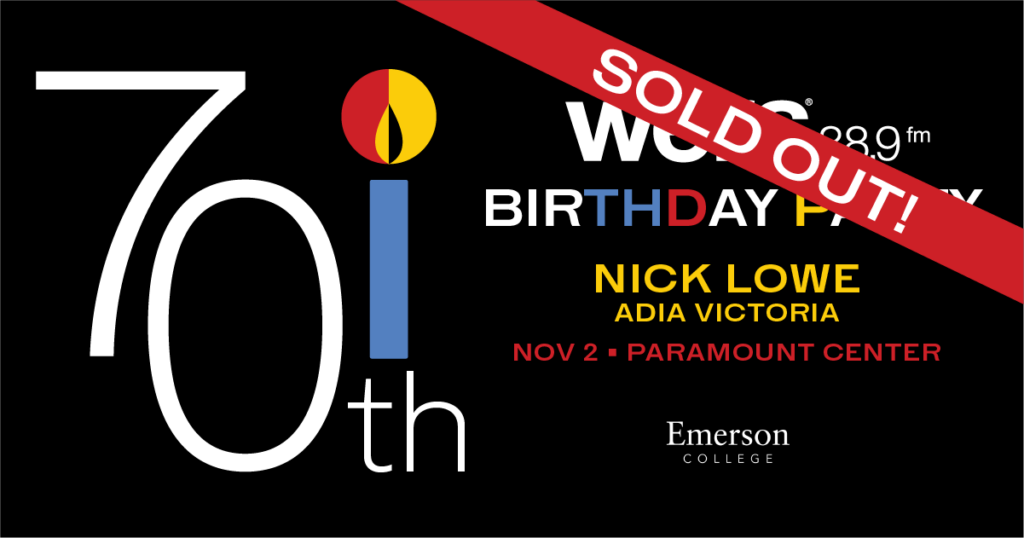ERS-Plus is turning up the volume on Hip-Hop. Want more Hip-Hop and R&B? Check out ERS-Plus on 88.9FM HD2 and online at WERSPlus.org.
By Kathia Dawson, Urban Coordinator
HIP HOP SCENE & EARLY BEGINNINGS
The 80s and 90s Hip-Hop scene is marked by innovation, artistry of lyricism, and pushing boundaries – coining it the Golden Age. Regional styles of rap were developing in full force. East Coast, West Coast, and Southern Hip-Hop scenes developed their own styles.
The pioneering young Hip Hop trio, De La Soul, changed Hip-Hop music forever when they released their debut album 3 Feet High and Rising. Consisting of three Long Island suburban high schoolers: David Jolicoeur (Trugoy the Dove/Dave/Plug Two), Kelvin Mercer (Posdnuos/Plug One), Vincent Mason (P.A./ Pasemaster Mase/Maseo/Plug Three). The group brought a fresh perspective to Hip-Hop with their “new style of speak,” challenging the limitations of what Hip-Hop was in that time.
Their story starts at Amityville High School where the three young boys were confined to summer school classes for, ironically, English class. Childhood friends, Mercer and Jolicoeur, crossed paths with one of the more popular DJs in town, Mason, in the early 1980s during their high school years. Their collaborative musical journey started in 1986 in the basement of one of their homes where they playfully experimented with sounds while recording. Mason, DJing at different backyard parties, crossed paths with Prince Paul, the producer and leader of the New York rap group Stetsasonic. He gave Prince Paul a demo tape from De La Soul. Impressed by their sound, Prince Paul played it for some of his colleagues, ultimately paving the way for the group to secure a contract with Tommy Boy Records, while also becoming a co-producer of the album.
They had incorporated jokes into their music – a new trend never seen in Hip-Hop before. Sooner or later they had jumped up front the basement to a studio with Stetsasonic’s Prince Paul. Paul assisted in getting them studio time in Manhattan. The group steered away from gangsta rap and instead held a whimsical comical brew of music. Even after the commercial success of their first album, all of the boys remained in school. The group soon gained them the nickname “hippies of Hip-Hop.” Soon they were seen as leaders of the New York-based rap collective known as the Native Tongues Posse.
Harmony in Hip-Hop: The Native Tongues Posse
The Native Tongues collective started with three successful Hip-Hop groups, Jungle Brothers, De La Soul, and A Tribe Called Quest. They pushed Hip-Hop music into new directions in the early 1990s. According to Truegoy, “The Native Tongues came about where basically, we had a show together in Boston. We had a natural love for art and a natural love for each other.”
De La Soul invited the Jungle Brothers to a session when recording the song “Buddy.” Their hanging produced not only fun, but an exchange of ideas. It became the collective’s most notable release. ATCQ’s Q-Tip said, “In Hip-Hop, it praises individualism. I think that’s the main achievement of The Native Tongues. It just showed people could come together.” Core members all shared a common vision in music, fashion, Afro diasporic themes, and positive Afrocentric lyrics. Other members of the crew included Queen Latifiah, Monie Love and Black Sheep.
Producer Pharrell Williams once said.“That whole Native Tongues organization set so many of us free.” Artists such as OutKast, Kendrick Lamar and John Legend cite them as influential.
A LOOK THROUGH THEIR ALBUMS
Their first album recorded in the spring of 1989, it stretched the boundaries of Hip-Hop culture. The group emphasized peace and love, a stark contrast to popular 90s gangsta rap. The album grabbed inspiration from diverse sources such as Johnny Cash, Steely Dan, Hall & Oates, and The Turtles. It was an eclectic album with low-key rhymes and humor. The album encouraged listeners to reject conformity.
The album peaked to #15 on the Billboard 200 charting for 30 weeks. It was a top in album sales. Multiple universities named it one of the most influential albums in Hip-Hop history. Rolling Stone magazine charted it on their 200 Greatest Hip-Hop Albums and listed it at #33. The Library of Congress entered the album into the
National Recording Registry for its cultural significance.
The second album from the group marked a sharp turn from the “hippie” persona associated with their first album. It delves into themes of mortality, and challenges of success. The album takes on a nihilistic and hyper-materialistic tone. Achieving a peak position at 26 on the Billboard 200, the album remained on the charts for an impressive 17 weeks.
It was a sharp break from the image the public had of them. It featured funny skits, multiple storylines about a fictional radio station, and unimpressed teens listening to the album. Original songs included “Bitties in the BK Lounge”, and “A Rollerskating Jam Named “Saturdays”.” It was an album proving they could stand among Hip-Hop’s most audacious songwriters.
Released in the spring of 1991, De La Soul’s third album diverged even further from their debut. Unfortunately, this shift in style didn’t align with audience expectations and the album failed to achieve the commercial success they sought. The only track to break into the R&B Top 40 was “Breakdown.”
Stakes Is High (1996)
It was the group’s first album without Prince Paul. The album’s peak position was #13 on Billboard’s 200 and introduced the music world to Mos Def.
Art Official Intelligence: Mosaic Thump (2000)
This was the first volume in their proposed trilogy. The album featured guest appearances by Busta Rhymes, the Beastie Boys, and Redman among others. Greeted warmly by record buyers, it debuted in the top ten. The first of the trilogy, it topped Billboard 200 and debuted at #9 with more than 80,000 sold in the first week. “Oooh” featuring Redman was a standout single.
The second album of the trilogy was closer to De La Soul’s original sound with guest features from Slick Rick, B-Real, Devin the Dude, and Cee-Lo Green. The group’s longtime label Tommy Boy Records started to slow down promotional efforts and this cut the trilogy short. AOI’s single “Baby Phat” was the group’s last Hip-Hop radio hit.
And the Anonymous Nobody… (2016)
This album is all over the rap genre. It includes notable names such as Usher, David Byrne, 2 CHainz and more. The spacey melodic stretches don’t diminish the Hip-Hop sound at its core. It had top album sales at #7.
SPOTLIGHT TRACKS
This song was originally on the (I)3 Feet High and Rising album. The “Buddy” remix included Native Tongues members Queen Latifah and Monie Love, but the original featured the Jungle Brothers and the studio version included Q-Tip.
Achieving Top 40 status in the U.S. including a number one spot on the R&B charts, this track earned a gold certification. Noteworthy for sampling Funkadelic’s, “(Not Just) Knee Deep,” and Ohio Players’ “Funky Worm,” the track’s sampling approach is tantamount to covering iconic songs like The Beatles. It remained a quintessential crowd-pleaser for De La Soul fans, symbolizing their early success.
“Stakes is High” marked a personal and pivotal release for the group, especially given the uncertainty following their previous album, Buhloone’s Mindstate. Released on July 2nd, this track stands as their most critical work and featured a mini Native Tongues reunion. While De La’s outspokenness wasn’t new, this album directly confronted the rising clutches in Hip-Hop, challenging the genre’s direction and expressing unease about the state of the world.
AWARDS
Grammy Nominations
1990 “Me Myself and I” (Single) Best Rap Performance
2001 “Oooh” (Single) Best Rap Performance By A Duo Or Group
2006 “Feel Good Inc” Best Short Form Music Video/ Record Of The Year
2017 “And The Anonymous Nobody” Best Rap Album
Other nominations
1990 3 Feet High and Rising Soul Train Award for Best Rap Album
1990 “Eye Know” British Video of the Year
Awards Won
2006 “Feel Good Inc.” Best Pop Collaboration With Vocals
INFLUENCE AND LEGACY
De La Soul’s impact on both Hip-Hop and American culture is deep-seated and enduring. They are renowned for their innovative approach to lyricism and production.
Beyond musical contributions, De La challenged established norms within Hip-Hop culture. They rejected stereotypes and emphasized individuality and positivity, which marked paradigm shift. From their colorful aesthetic, which diverged from the prevalent streetwear culture to social commentary and advocacy for artistic freedom, the trio’s longevity in history is credited to their consistency and delivery of thought-provoking and genre-defying music.
In February of 2023 David Jolicoeur, De La Soul’s Trugoy, a.k.a. The Dove, died at age 54 of congestive heart failure. His death led to a rediscovery of De La Soul, bringing them back to the top of the Billboard charts once again. De La Soul is definitely one of the most influential groups of it’s time leaving room in the rich tapestry of Hip-Hop to include me, you and all of intricate selves.


